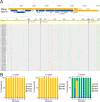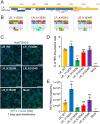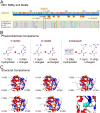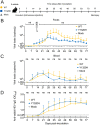Ribavirin Treatment Failure-Associated Mutation, Y1320H, in the RNA-Dependent RNA Polymerase of Genotype 3 Hepatitis E Virus (HEV) Enhances Virus Replication in a Rabbit HEV Infection Model
- PMID: 36809085
- PMCID: PMC10128057
- DOI: 10.1128/mbio.03372-22
Ribavirin Treatment Failure-Associated Mutation, Y1320H, in the RNA-Dependent RNA Polymerase of Genotype 3 Hepatitis E Virus (HEV) Enhances Virus Replication in a Rabbit HEV Infection Model
Abstract
Chronic hepatitis E virus (HEV) infection has become a significant clinical problem that requires treatment in immunocompromised individuals. In the absence of an HEV-specific antiviral, ribavirin (RBV) has been used off-label, but treatment failure may occur due to mutations in the viral RNA-dependent RNA polymerase (RdRp), including Y1320H, K1383N, and G1634R. Chronic hepatitis E is mostly caused by zoonotic genotype 3 HEV (HEV-3), and HEV variants from rabbits (HEV-3ra) are closely related to human HEV-3. Here, we explored whether HEV-3ra, along with its cognate host, can serve as a model to study RBV treatment failure-associated mutations observed in human HEV-3-infected patients. By utilizing the HEV-3ra infectious clone and indicator replicon, we generated multiple single mutants (Y1320H, K1383N, K1634G, and K1634R) and a double mutant (Y1320H/K1383N) and assessed the role of mutations on replication and antiviral activity of HEV-3ra in cell culture. Furthermore, we also compared the replication of the Y1320H mutant with the wild-type HEV-3ra in experimentally infected rabbits. Our in vitro analyses revealed that the effects of these mutations on rabbit HEV-3ra are altogether highly consistent with those on human HEV-3. Importantly, we found that the Y1320H enhances virus replication during the acute stage of HEV-3ra infection in rabbits, which corroborated our in vitro results showing an enhanced viral replication of Y1320H. Taken together, our data suggest that HEV-3ra and its cognate host is a useful and relevant naturally occurring homologous animal model to study the clinical relevance of antiviral-resistant mutations observed in human HEV-3 chronically-infected patients. IMPORTANCE HEV-3 causes chronic hepatitis E that requires antiviral therapy in immunosuppressed individuals. RBV is the main therapeutic option for chronic hepatitis E as an off-label use. Several amino acid changes, including Y1320H, K1383N, and G1634R, in the RdRp of human HEV-3 have reportedly been associated with RBV treatment failure in chronic hepatitis E patients. In this study, we utilized an HEV-3ra from rabbit and its cognate host to investigate the effect of these RBV treatment failure-associated HEV-3 RdRp mutations on viral replication efficiency and antiviral susceptibility. The in vitro data using rabbit HEV-3ra was highly comparable to those from human HEV-3. We demonstrated that the Y1320H mutation significantly enhanced HEV-3ra replication in cell culture and enhanced virus replication during the acute stage of HEV-3ra infection in rabbits. The rabbit HEV-3ra infection model should be useful in delineating the role of human HEV-3 RBV treatment failure-associated mutations in antiviral resistance.
Keywords: chronic hepatitis E (CHE); genotype 3 HEV (HEV-3); hepatitis E virus (HEV); rabbit HEV-3ra; ribavirin (RBV) treatment failure-associated mutations.
Conflict of interest statement
The authors declare no conflict of interest.
Figures







Similar articles
-
Hepatitis E virus mutations associated with ribavirin treatment failure result in altered viral fitness and ribavirin sensitivity.J Hepatol. 2016 Sep;65(3):499-508. doi: 10.1016/j.jhep.2016.05.002. Epub 2016 May 9. J Hepatol. 2016. PMID: 27174035
-
Modelling of Hepatitis E virus RNA-dependent RNA polymerase genotype 3 from a chronic patient and in silico interaction analysis by molecular docking with Ribavirin.J Biomol Struct Dyn. 2023 Feb;41(2):705-721. doi: 10.1080/07391102.2021.2011416. Epub 2021 Dec 3. J Biomol Struct Dyn. 2023. PMID: 34861797
-
Zinc Salts Block Hepatitis E Virus Replication by Inhibiting the Activity of Viral RNA-Dependent RNA Polymerase.J Virol. 2017 Oct 13;91(21):e00754-17. doi: 10.1128/JVI.00754-17. Print 2017 Nov 1. J Virol. 2017. PMID: 28814517 Free PMC article.
-
Mutagenic Effects of Ribavirin on Hepatitis E Virus-Viral Extinction versus Selection of Fitness-Enhancing Mutations.Viruses. 2016 Oct 13;8(10):283. doi: 10.3390/v8100283. Viruses. 2016. PMID: 27754363 Free PMC article. Review.
-
Hepatitis E virus treatment and ribavirin therapy: viral mechanisms of nonresponse.Curr Opin Virol. 2018 Oct;32:80-87. doi: 10.1016/j.coviro.2018.10.001. Epub 2018 Oct 29. Curr Opin Virol. 2018. PMID: 30384328 Review.
Cited by
-
The Diagnosis, Pathophysiology, and Treatment of Chronic Hepatitis E Virus Infection-A Condition Affecting Immunocompromised Patients.Microorganisms. 2023 May 16;11(5):1303. doi: 10.3390/microorganisms11051303. Microorganisms. 2023. PMID: 37317277 Free PMC article. Review.
-
Research Progress on Hepatitis E Virus Culture.Pathogens. 2025 May 6;14(5):456. doi: 10.3390/pathogens14050456. Pathogens. 2025. PMID: 40430776 Free PMC article. Review.
-
Drug repurposing screen identifies vidofludimus calcium and pyrazofurin as novel chemical entities for the development of hepatitis E interventions.Virol Sin. 2024 Feb;39(1):123-133. doi: 10.1016/j.virs.2023.11.006. Epub 2023 Nov 19. Virol Sin. 2024. PMID: 37984761 Free PMC article.
-
Identification of novel rodent and shrew orthohepeviruses sheds light on hepatitis E virus evolution.Zool Res. 2025 Jan 18;46(1):103-121. doi: 10.24272/j.issn.2095-8137.2024.298. Zool Res. 2025. PMID: 39846190 Free PMC article.
-
Phosphorylation of Ser711 residue in the hypervariable region of zoonotic genotype 3 hepatitis E virus is important for virus replication.mBio. 2024 Nov 13;15(11):e0263524. doi: 10.1128/mbio.02635-24. Epub 2024 Oct 8. mBio. 2024. PMID: 39377575 Free PMC article.
References
Publication types
MeSH terms
Substances
Grants and funding
LinkOut - more resources
Full Text Sources
Research Materials
